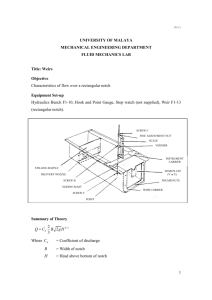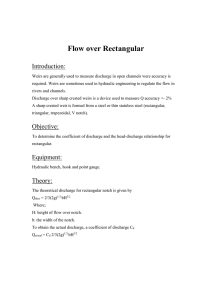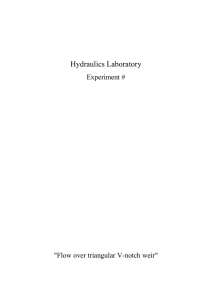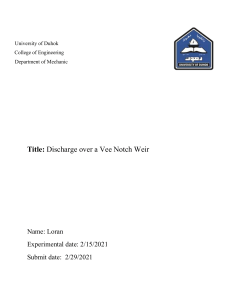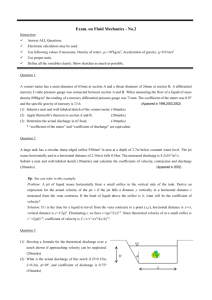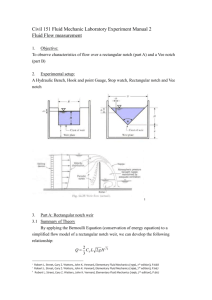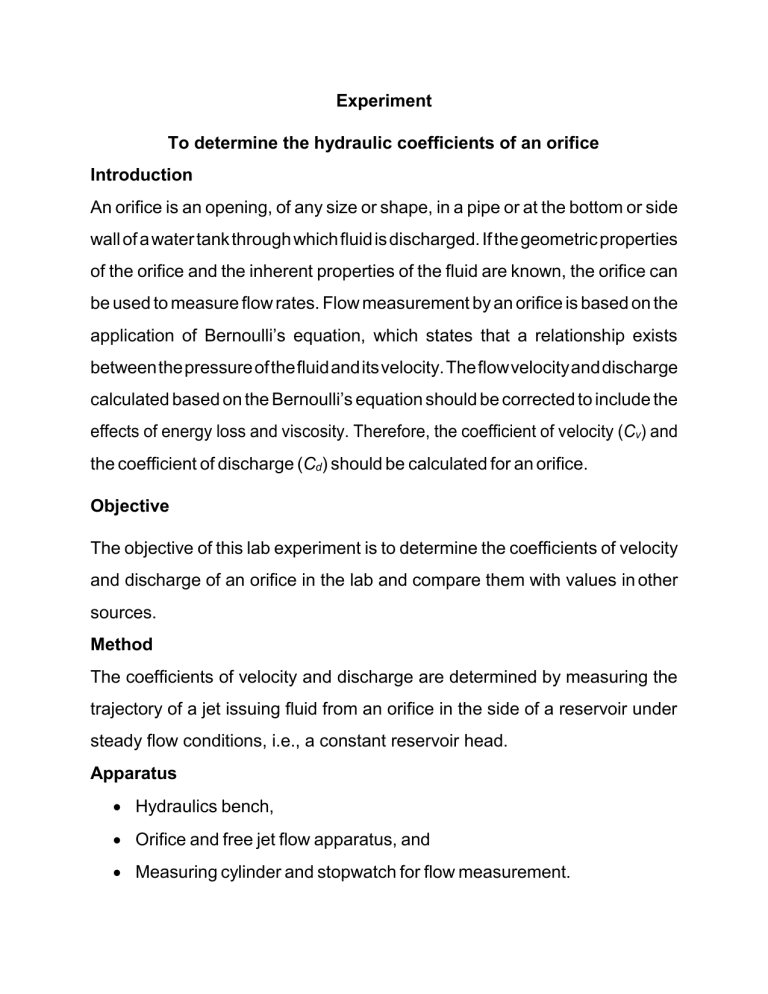
Experiment To determine the hydraulic coefficients of an orifice Introduction An orifice is an opening, of any size or shape, in a pipe or at the bottom or side wall of a water tank through which fluid is discharged. If the geometric properties of the orifice and the inherent properties of the fluid are known, the orifice can be used to measure flow rates. Flow measurement by an orifice is based on the application of Bernoulli’s equation, which states that a relationship exists between the pressure of the fluid and its velocity. The flow velocity and discharge calculated based on the Bernoulli’s equation should be corrected to include the effects of energy loss and viscosity. Therefore, the coefficient of velocity (Cv) and the coefficient of discharge (Cd) should be calculated for an orifice. Objective The objective of this lab experiment is to determine the coefficients of velocity and discharge of an orifice in the lab and compare them with values in other sources. Method The coefficients of velocity and discharge are determined by measuring the trajectory of a jet issuing fluid from an orifice in the side of a reservoir under steady flow conditions, i.e., a constant reservoir head. Apparatus Hydraulics bench, Orifice and free jet flow apparatus, and Measuring cylinder and stopwatch for flow measurement. Procedure This experiment will be performed in two parts. Part A is performed to determine the coefficient of velocity, and Part B is conducted to determine the coefficient of discharge. Set up the equipment as follows: Locate the apparatus over the channel in the top of the bench. Using the spirit level attached to the base, level the apparatus by adjusting the feet. Connect the flexible inlet tube on the side of the head tank to the bench quick-release fitting. Place the free end of the flexible tube from the adjustable overflow on the side of the head tank into the volumetric. Make sure that this tube will not interfere with the trajectory of the jet flowing from the orifice Secure each needle in the raised position by tightening the knurled screw. Part A: Determination of coefficient of velocity Close the bench flow control valve, switch on the pump, and then gradually open the bench flow control valve. When the water level in the head tank reaches the top of the overflow tube, adjust the bench flow control valve to provide a water level of 2 to 3 mm above the overflow pipe level. This will ensure a constant head and produce a steady flow through the orifice. If necessary, adjust the frame so that the row of needles is parallel with the jet, but is located 1 or 2 mm behind it. This will avoid disturbing the jet, but will minimize errors due to parallax. Attach a sheet of paper to the backboard, between the needles and board, and secure it in place with the clamp provided so that its upper edge is horizontal. Position the overflow tube to give a high head. The jet trajectory is obtained by using the needles mounted on the vertical backboard to follow the profile of the jet. Release the securing screw for each needle, and move the needle until its point is just immediately above the jet. Re-tighten the screw. Mark the location of the top of each needle on the paper. Note the horizontal distance from the plane of the orifice to the coordinate point marking the position of the first needle. This first coordinate point should be close enough to the orifice to treat it as having the value of y=0. Thus, y displacements are measured relative to this position. The volumetric flow rate through the orifice can be determined by intercepting the jet, using the measuring cylinder and a stopwatch. Part B: Determination of coefficient of discharge Position the overflow tube to have a suitable head in the tank. Measure the flow rate by timed collection, using the measuring cylinder provided. Repeat this procedure for another suitable value of head. Observations and Calculations Use the following tables to record the measurements Diameter of an orifice, d = Area of an orifice, Ao = Sr. No. y Head (h) x Trial 1 Trial 2 Trial 3 Trial 1 Trial 2 Trial 3 1 2 3 4 5 Part A (for each trial) Sr. No. 1 2 3 4 5 x y h (y.h)1/2 Cv Part B (for each trial) Sr. No. x y h1/2 Q Cd 1 2 3 4 5 The value of Cv can be determined from the x, y coordinates of the jet trajectory. A graph of x plotted against (y.h)1/2 will have a slope of 2Cv The value of Cd can be determined from the following equations. A graph of Q plotted against h1/2 will have a slope (s). Experiment To determine the coefficient of discharge for a triangular notch Introduction A weir is a barrier across the width of a river or stream that alters the characteristics of the flow and usually results in a change in the height of the water level. Several types of weirs are designed for application in natural channels and laboratory flumes. Weirs can be broad-crested, short-crested, or sharpcrested. Sharp-crested weirs are commonly referred to as notches. A coefficient of discharge needs to be determined experimentally for each weir to account for errors in estimating the rate of flow passing over the weir. Objective The objectives of this experiment are to: determine the characteristics of flow over a triangular notch, and determine the value of the discharge coefficient for a triangular notch. Method The coefficient of discharge is determined by measuring the height of the water surface above the notch base and the corresponding flow rate. The general features of the flow can be determined by direct observation. Apparatus Hydraulic bench, Triangular notch plate, Vernier height gauge, and Stopwatch Procedure This experiment will be performed by taking the following steps: Ensure that the hydraulics bench is positioned so that its surface is horizontal. This is necessary because the flow over the notch is driven by gravity. Mount the triangular notch plate onto the flow channel, and position the stilling baffle. Turn on the pump, and slightly adjust the flow control to fill the channel upstream of the weir with water. Turn off the pump when the water starts to flow over the weir. Wait a few minutes to allow the water to settle. Level the point gauge with the water level in the channel. Record the readings as ho and h. Turn on the pump, and slightly adjust the flow until the water level coincides with the point gauge. Check that the level has stabilized before taking readings. Measure the flow rate using the volumetric tank. Observe the shape of the nappe and take pictures of it. Note: To obtain an accurate measurement of the undisturbed water level above the crest of the weir, it is necessary to place the measuring gauge at a distance of at least three times the head above the weir. Increase the flow by opening the bench regulating valve to set the heads above the datum level with 10 mm increment until the regulating valve is fully open. Take care not to allow spillage to occur over the plate top that is adjacent to the notch. At each condition, measure the flow rate and observe the shape of the nappe. Collect at least seven head and discharge readings. Observations and Calculations Use the following table to record the measurements Angle of V-notch, θ = Datum height, ho = Water depth above V-notch (H) = Water surface elevation (h) - Datum height (ho) Sr. h No. H H5/2 Q Cd % Error Experimental Theoretical 1 2 3 4 5 6 7 The experimental and theoretical values of coefficient of discharge (Cd) for a triangular or V-notch are calculated by following equations respectively. where Q = m H5/2 Experiment To determine the coefficient of discharge for a rectangular notch Introduction A weir is a barrier across the width of a river or stream that alters the characteristics of the flow and usually results in a change in the height of the water level. Several types of weirs are designed for application in natural channels and laboratory flumes. Weirs can be broad-crested, short-crested, or sharpcrested. Sharp-crested weirs are commonly referred to as notches. A coefficient of discharge needs to be determined experimentally for each weir to account for errors in estimating the rate of flow passing over the weir. Objective The objectives of this experiment are to: determine the characteristics of flow over a rectangular notch, and determine the value of the discharge coefficient for a rectangular notch. Method The coefficient of discharge is determined by measuring the height of the water surface above the notch base and the corresponding flow rate. The general features of the flow can be determined by direct observation. Apparatus Hydraulic bench, Rectangular notch plate, Vernier height gauge, and Stopwatch Procedure This experiment will be performed by taking the following steps: Ensure that the hydraulics bench is positioned so that its surface is horizontal. This is necessary because the flow over the notch is driven by gravity. Mount the rectangular notch plate onto the flow channel, and position the stilling baffle. Turn on the pump, and slightly adjust the flow control to fill the channel upstream of the weir with water. Turn off the pump when the water starts to flow over the weir. Wait a few minutes to allow the water to settle. Level the point gauge with the water level in the channel. Record the readings as ho and h. Turn on the pump, and slightly adjust the flow until the water level coincides with the point gauge. Check that the level has stabilized before taking readings. Measure the flow rate using the volumetric tank. Observe the shape of the nappe and take pictures of it. Note: To obtain an accurate measurement of the undisturbed water level above the crest of the weir, it is necessary to place the measuring gauge at a distance of at least three times the head above the weir. Increase the flow by opening the bench regulating valve to set the heads above the datum level with 10 mm increment until the regulating valve is fully open. Take care not to allow spillage to occur over the plate top that is adjacent to the notch. At each condition, measure the flow rate and observe the shape of the nappe. Collect at least seven head and discharge readings. Observations and Calculations Use the following table to record the measurements Width of R-notch, b = Datum height, ho = Water depth above R-notch (H) = Water surface elevation (h) - Datum height (ho) Sr. h No. H H3/2 Q Cd % Error Experimental Theoretical 1 2 3 4 5 6 7 The experimental and theoretical values of coefficient of discharge (Cd) for a rectangular or R-notch are calculated by following equations respectively. where Q = m H3/2
